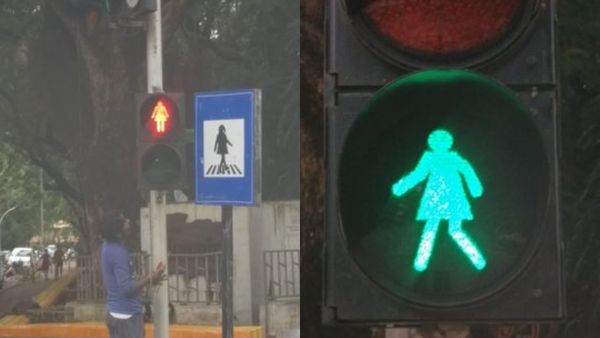Mumbai has replaced symbols of men on traffic lights with symbols of women wearing dresses.
India's largest city is the country's first to install the 240 pedestrian signals in an effort to express the government's commitment to improving gender equality for women.
Assistant commissioner Kiran Dighavkar got the idea from an urban planning organisation, Urban Growth, who wanted to change society's constant messaging that men are representative for all people.
Maharashtra's cabinet minister for tourism and the environment, Aaditya Thackeray, is heading the 'Culture Spine' initiative responsible for implementing the new symbols.
He tweeted on Saturday: 'If you've passed by Dadar, you'd see something that will make you feel proud.'
'(The local administration is) ensuring gender equality with a simple idea -- the signals now have women too!'
India was classified the most dangerous place for women in 2018 because of its high levels of domestic and sexual violence.
The Thomson Reuters Foundation poll of 550 global experts made the classification based on the 33,356 rapes and 89,097 assaults that year.
Although India has several women leaders, including the country's first woman prime minister, many girls do not even receive an education.
Girls have higher survival rates at birth globally but India is the only country in the world more girls die than boys, according to UNICEF India.
Other countries, including Germany and Australia, have also rolled out women icons on pedestrian crossings to try and make women as representative symbols of people too.
Vienna used images of same-sex couples for the Eurovision Son Contest in 2015 and have since kept them.
Geneva made an effort to include diverse representation and used symbols of women in dresses as well as trousers, pregnant women, older women, a woman with an afro and two women holding hands.
After a student was gang raped and murdered a New Delhi bus in 2012 the role of urban planning was brought to the forefront of the ongoing conversation about gender equality in India.
India's cities started to look at how changing dark corners, remote bus stops and introduced reforms like making public transport free for women so there were more women on public transport to keep other women safe.
New Delhi also introduced women's help desks at each of the city's police stations.
Critics of the new women symbols have said that figures in dresses are not going to do anything to bring domestic and sexual violence down in the country.
Sneha Visakha, a legal researcher, told the New York Times that symbolism without wider change is useless in country where women are in danger all the time.
She said: 'We finally have a figure in a traffic signal so now women are equal to men?'
'It's so patronising.'
This article has been adapted from its original source.








